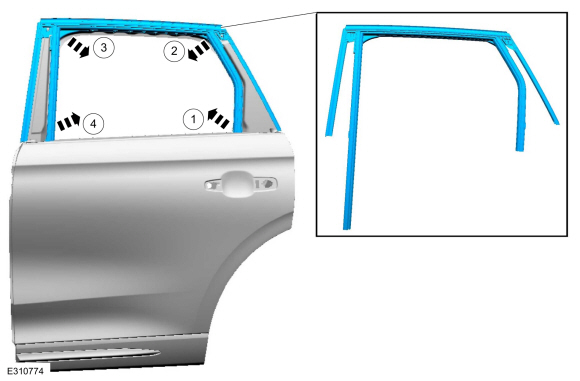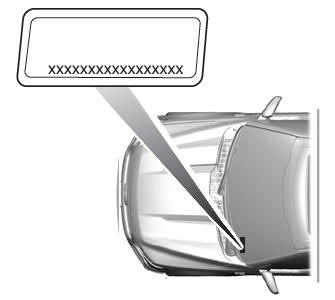Ford Escape: Starting System - 1.5L EcoBoost (132kW/180PS) – I3 (Y1) / Description and Operation - Starting System - System Operation and Component Description
System Operation
System Diagram

| Item | Description |
|---|---|
| 1 | PCM |
| 2 | Starter Relay |
| 3 | Starter Motor |
| 4 | BCM |
| 5 | Brake Pedal Position Switch |
| 6 | Clutch Pedal Switch (Manual Transmission) |
| 7 | Ignition Switch |
Network Message Chart
Module Network Input Messages Powertrain Control Module (PCM)
| Broadcast Message | Originating Module | Message Purpose |
|---|---|---|
| Crank request | BCM | Provides the PCM with indication that the driver has commanded the engine to crank. |
| Power mode | BCM | Provides the PCM with ignition mode. |
| Ignition status | BCM | Provides the PCM with ignition mode. |
Starting System
The BCM controls the ignition modes and, in conjunction with the PCM , the starting system.
During a start event, when the ignition switch is turned to Start (without push button start) or the engine start/stop switch and the brake pedal (automatic transmission) or the clutch pedal (manual transmission) are pressed (with push-button start), the PCM and BCM receive a request to start the engine. The PCM recognizes the correct inputs from the BCM and TR sensor ( TR is only used by PCM when automatic transmission) and provides voltage and ground to energize the starter relay coil and close the starter relay contacts. The starter relay contacts close, providing voltage to the starter solenoid, allowing the starter motor to crank the engine. The PCM disengages the starter motor once an engine RPM threshold is reached, a set crank time is exceeded or the ignition switch is turned to off (without push button start) or the start/stop button is pressed (with push-button start).
If cumulative crank time exceeds 60 seconds within 60 minutes, the starter will be inhibited for 15 minutes to protect starter motor and the PCM sets a DTC . Refer to the Owner's Literature for more information.
Auto-Start-Stop System
The Auto-start-stop system helps reduce fuel consumption by automatically shutting off the vehicle’s engine while the vehicle is at a complete stop and restarting the engine when the clutch pedal is pressed (with manual transmission) or when the brake pedal is released (with automatic transmission). The system can be disabled through the auto-start-stop disable switch on the instrument panel centerstack. The Auto-start-stop system is automatically enabled whenever the ignition is turned on.
The engine automatically restarts when:
- the brake pedal is released.
- the Auto-start-stop system is disabled through the auto-start-stop disable switch on the instrument panel centerstack.
- the battery has a low state of charge.
- it is necessary to maintain interior comfort.
- there is low brake vacuum.
The Auto-start-stop system may not turn the engine off under these conditions:
- the HVAC system is in A/C, heat or defrost modes.
- the battery has a low state of charge.
- the battery temperature is below 5°C (41°F) or above 60°C (140°F).
- the engine temperature is warming up.
- the steering wheel is turned rapidly or is at a sharp angle.
- the vehicle is on a steep road grade.
- elevation is at very high altitude.
Refer to the Owner's Literature for additional information.
Passive Anti-theft System (PATS)
This vehicle is equipped with PATS . PATS disables the engine from starting if an unprogrammed PATS key is used or an invalid PCM ID is received. The PATS is controlled by the BCM . If there is a PATS concern that disables the engine, the IPC displays a corresponding message in the message center. Refer to: Passive Anti-Theft System (PATS) - System Operation and Component Description (419-01B Passive Anti-Theft System (PATS) - Vehicles Without: Keyless Entry and Push Button Start, Description and Operation). (without Push Button Start) or Refer to: Passive Anti-Theft System (PATS) - System Operation and Component Description (419-01C Passive Anti-Theft System (PATS) - Vehicles With: Keyless Entry and Push Button Start, Description and Operation).Refer to: Passive Anti-Theft System (PATS) - System Operation and Component Description (419-01C Passive Anti-Theft System (PATS) - Vehicles With: Keyless Entry and Push Button Start, Description and Operation). (with Push Button Start)
Component Description
Ignition Switch (without Push Button Start)
Refer to: Steering Wheel and Column Electrical
Components (211-05 Steering Wheel and Column Electrical Components -
1.5L EcoBoost (132kW/180PS) - I3)
.
Ignition Switch - Push Button Start (with Push Button Start)
The ignition switch - push button start (Engine Start/Stop button)
is a momentary contact switch that is hardwired to the BCM and the PCM .
The ignition switch - push button start is used to obtain the OFF, ON
or START ignition modes. For more information,
Refer
to: Steering Wheel and Column Electrical Components (211-05 Steering
Wheel and Column Electrical Components - 1.5L EcoBoost (132kW/180PS) -
I3)
.
Integrated Keyhead Transmitter (IKT) (without Push Button Start)
Refer to: Passive Anti-Theft System (PATS) - System Operation and Component Description (419-01B Passive Anti-Theft System (PATS) - Vehicles Without: Keyless Entry and Push Button Start, Description and Operation).
Passive Key (with Push Button Start)
Refer to: Passive Anti-Theft System (PATS) - System Operation and Component Description (419-01C Passive Anti-Theft System (PATS) - Vehicles With: Keyless Entry and Push Button Start, Description and Operation).
Passive Anti-Theft Transceiver
Refer to: Passive Anti-Theft System (PATS) - System Operation and Component Description (419-01B Passive Anti-Theft System (PATS) - Vehicles Without: Keyless Entry and Push Button Start, Description and Operation).
BCM
Refer to: Module Controlled Functions - Component Location (419-10 Multifunction Electronic Modules, Description and Operation).
PCM
The PCM provides power and ground to the starter relay to initiate cranking of the engine.
 Description and Operation - Starting System - Overview
Description and Operation - Starting System - Overview
Starting System
The starting system controls the cranking of the engine. When the
PCM
receives inputs from the ignition switch, transmission (with automatic
transmission) or clutch pedal position switch (with manual
transmission), run/start relay and the BCM it then energizes the BJB
starter relay...
 Diagnosis and Testing - Starting System
Diagnosis and Testing - Starting System
Diagnostic Trouble Code (DTC) Chart
Diagnostics in this manual assume a certain skill level and knowledge of Ford-specific diagnostic practices. REFER to: Diagnostic Methods (100-00 General Information, Description and Operation)...
Other information:
Ford Escape 2020-2025 Service Manual: General Procedures - Valve Guide Inner Diameter
Check NOTE: Refer to the appropriate Section 303-01 for the specification. NOTE: Valve guides tend to wear in an hourglass pattern. The ball gauge can be inserted into the combustion chamber side of the valve guide, if necessary. Use a ball gauge to determine the inside diameter of the valve guides in 2 directions at the top, middle and bottom of the valve guide...
Ford Escape 2020-2025 Service Manual: Removal and Installation - Lower Arm
Special Tool(s) / General Equipment Vehicle/Axle Stands Removal NOTICE: Suspension fasteners are critical parts that affect the performance of vital components and systems. Failure of these fasteners may result in major service expense...
Categories
- Manuals Home
- 4th Generation Ford Escape Owners Manual
- 4th Generation Ford Escape Service Manual
- Switching the Rear Window Wiper On and Off. Reverse Wipe
- Power Outlet - Vehicles With: 12V Power Outlet
- Plug-In Hybrid Electric Vehicle Drive Modes
- New on site
- Most important about car
Vehicle Identification
Locating the Vehicle Identification Number
The vehicle identification number is on the left-hand side of the instrument panel.


.jpg)